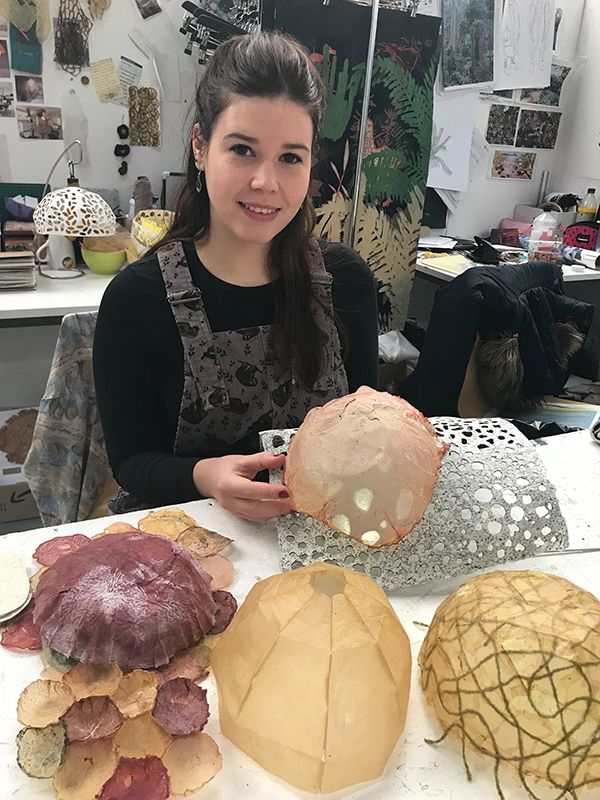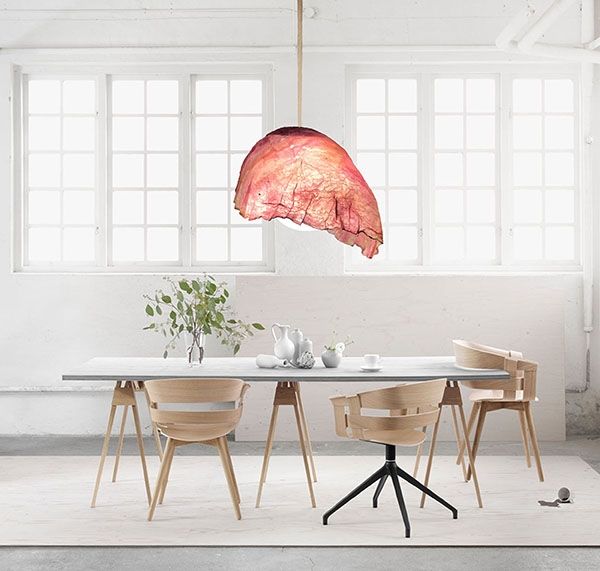
Eco-friendly leather could spell a more sustainable future for fashion
Eco-friendly leather could spell a more sustainable future for fashion
Imagine if you could help the environment by wearing clothing and using day-to-day items made using materials we grow ourselves, with any unwanted things thrown away in your garden for composting instead of being sent to landfill?
That’s what BA (Hons) Textile Design student Emily Hopkins believes could be achieved if manufacturers adopted widespread use of a type of 'vegan leather’.

She is using it to make lampshades for her final project and says she believes it is an example of the kind of materials which the textile industry could use instead of its staple sources of cotton and polyester.
Kombucha Leather is a type of bacterial cellulose also found in many plants, which creates a gel-like film grown by a symbiotic colony of bacteria and yeast (scoby). This feeds on a mixture of vinegar and sugar, and can be used to make anything from clothing and shoes, to handbags and lampshades.
Third-year student Emily makes it by mixing hot water, tea, and sugar together, before letting it cool, then adding vinegar and scoby, as well as occasionally food waste and natural dyes.
The liquid is then left for around three weeks and skin-like layer grows on the surface and can be removed, washed, and dried, ready for use. Emily has grown some almost a metre square.
Emily, who is vegetarian, is also working with materials made using everything from pineapple to beetroot and stinging nettles, and says these alternatives could ‘save millions of animals’ lives’ and help the environment.
“Imagine using natural materials you can grow in three weeks instead of the lengthy process currently used to manufacture a garment or other items,” said Emily. "I think sustainably-sourced materials make a great deal of sense.
“I am constantly experimenting with Kombucha Leather. Cellulose is the most abundant material in the world and I believe its potential hasn’t yet been fully explored.
“I believe it is a vital innovation and could broaden the diversity of materials used in textiles before we deplete all our natural resources. Textiles is the second most polluting industry in the world, so creating alternatives is a simple way to decrease its impact.”
Emily said her inspiration came from a ‘strong view that we need to sustain and protect our ecosystem before the point of no return’.

She added: “I am very passionate about this bio-material field of textile design and think it will be a key element in the future of fabrics.
“It is entirely biodegradable and can even be composted in your garden, making it a hugely sustainable way of both working and consuming.
“Through my work I hope to spread the message that bio-material innovation can be a major way to re-enforce sustainability in to interior and fashion products.
“My in-depth research in to this fascinating field of design has encouraged me to be more green and environmentally-conscience, further exploring tther textile innovations, and now my aim is for others to do the same.”
What is vegan leather?
American designer Suzanne Lee originated the idea of growing your own clothes and has inspired Emily’s work.
Lee developed a novel approach to fashion design by growing her own materials. Using a recipe of green tea, sugar, bacteria, and yeast she was able to 'grow' a material which she describes as a kind of ‘vegetable leather’.
This leather is more translucent than real protein leather and can have an almost papery texture. It looks more visually appealing when grown with natural dyes, with beetroot in particular providing a vibrant pink colour.
Lee co-founded the company Biocouture, in London, which works with scientists to bring living, bio-based materials to fashion.
Her approach is that instead of thinking about fibre production from a source like cotton in a field, with an agricultural approach manufacturers could look to living organisms like bacteria to produce fibres for us.
Picture caption 1: Emily Hopkins with paper, hand-made from stinging nettles, under a Kombucha Leather lamp.
Picture caption 2: How one of Emily's lamps could look in a kitchen.